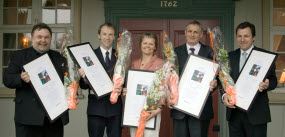
|
SINTEF’s Prize for Outstanding Research was awarded to these five. From left to right: Terje Føysa, Karsten Husby, Irene Anite Jensen, Odd Trandem and Jan Roar Pleym. Photo: Gry Karin Stimo / SINTEF Media |
Until now, orange balloons on power lines, brightly painted masts and lights have been the only warning that pilots receive when they are approaching and obstacle. But bad weather and poor light may reduce visibility to the point at which it is impossible to see an obstacle before it is too late.
Warns by radio
The new warning system, which two Norwegian pilots have developed in collaboration with SINTEF, warns pilots of a collision hazard irrespective or weather and visibility conditions. The system continuously monitors the air-space in the vicinity of a hazard, and warns pilots by radio of the danger of collision.
Awarded prize
The five scientists involved in the project have just shared SINTEF’s 2006 Prize for Outstanding Research. The award which is worth NOK 100 000, can go to current or former employees of the SINTEF Group.
The core of the system is a high-technology mast that is installed near the obstacle. The mast houses radar and information systems that register whether an aircraft is on course to collide with the hazard.
Auditory signal
When the aircraft is 30 seconds away the system actives powerful flashing lights. If avoiding action is not taken by the time that the aircraft is 20 seconds off and it continues on a collision course, a VHF transmitter in the mast is activated. This gives the pilot a clear and easily recognisable auditory signal, which is transmitted over all VHF air traffic channels in order to ensure that it reaches the pilot.
Available for everyone
The system does not require any special installation or added investment in aircraft themselves. It warns any planes that is in danger of colliding with an obstacle, irrespective of its type or nationality.
Pilots Rolf Bakken and Morten Mørk had the idea of a radio warning system for pilots in 1999. They approached SINTEF, which completed the system with radar technology in order to prevent it from giving false alarms to planes that were not actually on a collision course with an obstacle.
Obstacle Collision Avoidance System (OCAS) AS
In 2000, Bakken and Mørk set up a new company, Obstacle Collision Avoidance System (OCAS) AS, AS to produce and market the system. The company’s premises are in Oslo, and it has 17 employees.
To date, three trial systems have been installed in Norway, and test flights have confirmed that they work as they were intended to do.
The winners are...
SINTEF’s Prize for Outstanding Research was awarded to
Jan Roar Pleym (OCAS AS, formerly SINTEF ICT)
Irene Anite Jensen (SINTEF ICT)
Terje Frøysa (SINTEF ICT)
Karsten Husby (SINTEF ICT)
Odd Trandem (SINTEF ICT)
for their development of a radar system that warns of air traffic obstacles.
By Svein Tønseth |
